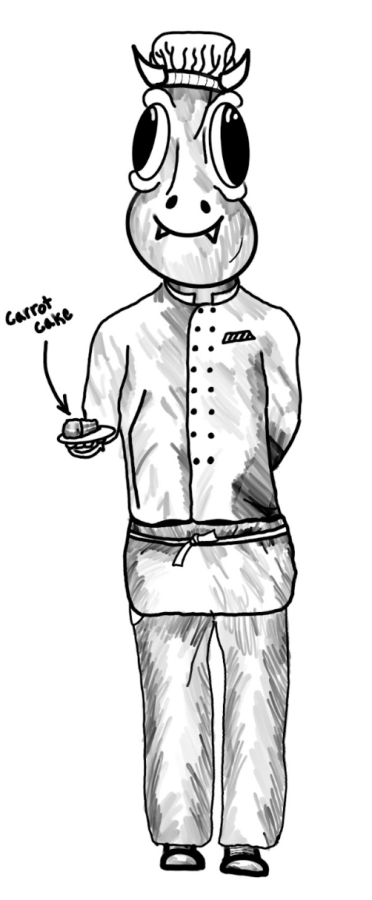Martha Turner’s Carrot Cake: A Baking Review
June 15, 2023
I forgot the oil. As the pans sat in the oven, the carrot cake baked away without its oil. For recipes like this, I recommend staying focused. Martha Turner’s Carrot Cake is a fan favorite. I have baked it three times: twice for my mother’s birthday and once this past weekend for my father’s. However, this time, I was surrounded by the laughter of my friends, which led to a slight disaster. I had to take the cakes out of the oven and stir in some last-minute oil to actually complete the recipe; nevertheless, the carrot cake came out clean.
According to National Today, carrot cake first appeared in 1827, in a French cookbook. During World War 2, England was forced to ration most sweeteners, cutting off the sugar supply to Brits with a sweet tooth, according to Culture Trip. Carrots rose to fame as their sweet nature and abundance became appreciated. Carrot cake took center stage.
Thanks to this recipe, even with the afterthought of removing the cakes from the oven to stir in the oil, the carrot cake remains loved. According to my mother, the “cake was a HUGE HIT.” Her friend Seth Ader commented, “I like the bit of carrot. Also, the icing-to-cake ratio was perfect. Plus, the texture and moisture were on point.”
Pertaining to Seth’s comments, I cut the carrots up small enough to still have a cake texture and that carrot taste with each bite. The icing-to-cake ratio came from the recipe, and for moisture, I made the cake itself the night before, placing it in cling film into the fridge. The next morning, I iced the cake and let it sit in an airtight cake holder. According to Betty Crocker’s website, here are some other tips to keep your cake moist:
- Don’t overbake!
- Using an airtight container is the best and easiest way to keep your cake from getting exposed to air. However, you can wrap your cake in cling film, or if it’s iced, place a large inverted bowl over it to trap the air.
By following these tips, I produced the cake I wanted. However, next time I bake this cake I will keep in mind a few things:
- Focus is important when contending with this recipe.
- A standing mixer would be helpful as well; however, I did use a handheld whisk. A good arm workout, I must say.
- Take the butter and the cream cheese out of the fridge before you begin. It’s much easier for it to blend when it has softened. If not, cut into smaller pieces before beginning to combine.
With that being said, I loved this recipe for its concise and clear language. By adding in details such as, “spoon flour into a dry-measuring cup and level off,” narrating how to properly incorporate the pinaapling by “folding” it in, and exactly how to ice the cake, Martha Turner’s recipe becomes easier. Without distraction, this recipe leads to a delicious cake for any level of baker.
According to The Early Show, “Four Recipes For ‘Perfect Cake’” by Rome Neal, “most people love to eat cake, but not everyone can be a master baker. You can come close, however, with help of Nick Malgieri, author of ‘Perfect Cake.’” In this article, Neal shares the four recipes that Malgieri chose out of the 200. One of those four is Martha Turner’s Carrot Cake. Below is the recipe:
MARTHA TURNER’S CARROT CAKE
Makes one 9-inch three-layer cake
About 16 servings
This is one of the few cakes which use canned fruit. The pineapple makes it moist and tart. Thanks to Martha Turner of Greensboro, North Carolina, for the recipe.
Cake Batter:
2 cups all-purpose flour (spoon flour into dry-measure cup and level off)
2 teaspoons baking powder
1 1/2 teaspoons baking soda
2 teaspoons ground cinnamon
4 large eggs
2 cups sugar
1 1/2 cups vegetable oil, such as corn or canola
2 cups peeled and finely grated carrots (about 4 large carrots)
One 8-ounce can crushed pineapple in juice
3/4 cup (about 3 ounces) pecans, coarsely chopped
Cream Cheese Icing:
12 ounces cream cheese, softened
12 tablespoons (1 1/2 sticks) unsalted butter, softened
1 tablespoon vanilla extract
1 cup (about 4 ounces) pecans, coarsely chopped and lightly toasted
6 cups confectioner’s sugar, sifted after measuring
Method:
Three 2-inch deep, 9-inch cake pans, buttered, with bottoms lined with buttered parchment or wax paper
- Set the racks in the upper and lower thirds of the oven and preheat to 325 degrees.
- Stir together the flour, baking powder, baking soda, and cinnamon in a bowl, mixing well.
- Whisk the eggs in a large mixing bowl. Whisk in the sugar and continue whisking briefly until light, about 1 minute. Whisk in the oil in a slow stream.
- Stir in the carrots, the pineapple with its juice, and the pecans, then fold in the dry ingredients. Scrape the batter into the prepared pans and smooth the tops.
- Bake for about 45 minutes, switching the position of the pans, top and bottom and back to front, once during baking, until the cake layers are firm and golden and a toothpick inserted in the center emerges clean.
- Cool the cake in the pans for 10 minutes, then invert onto racks to finish cooling. Remove the paper before icing.
- To make the icing, in the bowl of a heavy-duty mixer fitted with the paddle, beat the cream cheese, butter, and vanilla on medium speed until soft and light, about 5 minutes. Decrease the mixer speed to low and gradually beat in the confectioner’s sugar. Once the sugar is incorporated, increase the speed to medium and beat for 5 minutes longer.
- To assemble the cake, place one layer on a platter or cardboard round and spread one-third of the icing. Top with another layer and spread another third of the icing. Place the last layer on top. Bottom side up, and using a large offset spatula, frost the top and sides of the cake with the remaining icing. Sprinkle the toasted pecans on top of the cake, and press into sides.
Storage: Keep under an airtight dome at room temperature.


























